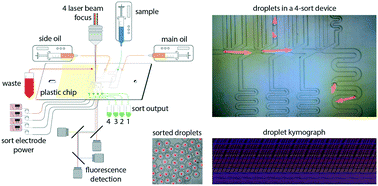Sorting droplets into many outlets†
Abstract
Droplet microfluidics is a commercially successful technology, widely used in single cell sequencing and droplet PCR. Combining droplet making with droplet sorting has also been demonstrated, but so far found limited use, partly due to difficulties in scaling manufacture with injection molded plastics. We introduce a droplet sorting system with several new elements, including: 1) an electrode design combining metallic and ionic liquid parts, 2) a modular, multi-sorting fluidic design with features for keeping inter-droplet distances constant, 3) using timing parameters calculated from fluorescence or scatter signal triggers to precisely actuate dozens of sorting electrodes, 4) droplet collection techniques, including ability to collect a single droplet, and 5) a new emulsion breaking method to collect aqueous samples for downstream analysis. We use these technologies to build a fluorescence based cell sorter that can sort with high (>90%) purity. We also show that these microfluidic designs can be translated into injection molded thermoplastic, suitable for industrial production. Finally, we tally the advantages and limitations of these devices.



 Please wait while we load your content...
Please wait while we load your content...